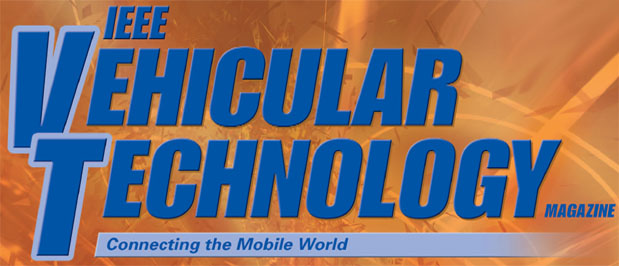Call For Papers: Special Issue on Emerging Technologies, Applications, and Standardizations for Connecting Vehicles (Part II)
Important Dates |
|
|---|---|
| Submission Deadline: | 1 July 2016 |
| First Editorial Decision: | 1 October 2016 |
| Acceptance Notification: | 15 January 2017 |
| Final Manuscripts Due: | 15 February 2017 |
| Publication: June 2017 | |
Vehicular transportation has become an essential pillar of economic growth and a key necessity of daily life for a large population over the last century. However, the increasing number of vehicles on roads results in more than one million human casualties due to vehicle crashes worldwide every year. In recent years, governments and industries have been working together to improve road traffic safety through various initiatives for intelligent transportation. Taking advantage of the advanced information and communication technology, the paradigm of vehicular communication and networking systems is gaining momentum around the globe. In particular, radio spectrum has been allocated in North America, Europe, and Japan for the dedicated short range communications (DSRC) to facilitate intelligent transportation. The United States Department of Transportation has been taking steps to enable vehicle-to-vehicle (V2V) communication technology in 2017 for light vehicles to avoid vehicle crashes. To realize the vision of accident-free transportation requires joint efforts among various sectors, from government agencies for policies and regulations to both telecom and automotive industries for technology development, standardizations, and services, and to academia for extensive research.
The aim of this special issue is to present a collection of high-quality research articles on the state-of-the-art in the emerging technology for V2V and vehicle-to-infrastructure (V2X) communications, the latest development in standardizations and regulations, and in potential services and applications for vehicles on roads. We are soliciting original contributions that have not been published and are not currently under consideration by any other journals. The topics of interest include, but are not limited to:
- Emerging technologies and standardizations, DSRC, mobility models, networking protocol optimization, multi-channel and cooperative V2V and V2X communications, content-centric vehicular networking, data offloading, vehicle smartphone integration, cellular-driven vehicular network, information security, user privacy protection, testbed, prototyping;
- Road safety, accident presentation, hazard reduction, intersection assistance, cooperative awareness basic service, misbehaviour detection and mitigation, case studies;
- Intelligent transportation, vehicle traffic modeling, decentralized congestion control, highway automation and platooning, autonomous cooperative driving, location-dependent services.
Submitted papers should contain state-of-the-art research material presented in a tutorial or survey style.
Regarding the manuscript format, authors must follow the IEEE Vehicular Technology Magazine guidelines. Articles should be about 3,000 to 4,000 words long with five to 10 figures and 10–15 references. The use of
mathematical equations should be limited to a maximum of three. All papers should be submitted online using ScholarOne Manuscripts: http://mc.manuscriptcentral.com/vtm-ieee
Guest Editors
Weihua Zhuang, University of Waterloo, Canada. Email: wzhuang@uwaterloo.ca
Abbas Jamalipour, University of Sydney, Australia. Email: a.jamalipour@ieee.org
Fan Bai, General Motors, USA. Email: fan.bai@gm.com
Alexey Vinel, Halmstad University, Sweden. Email : alexey.vinel@hh.se

